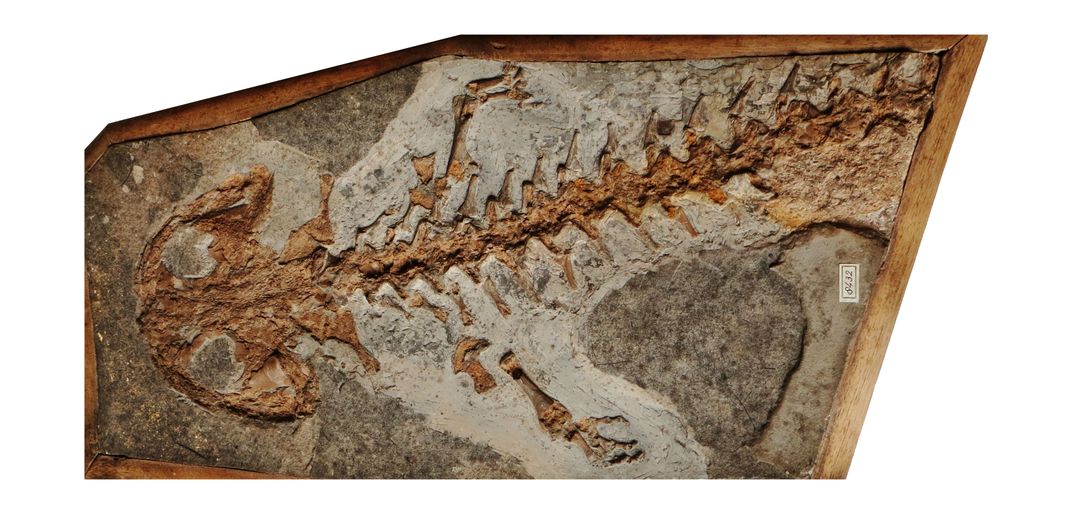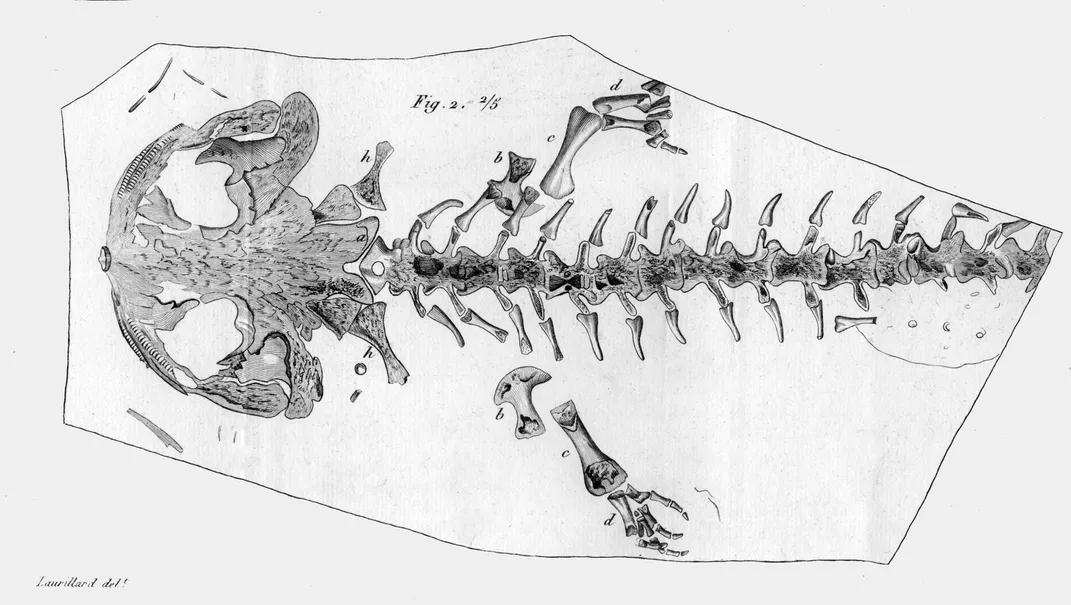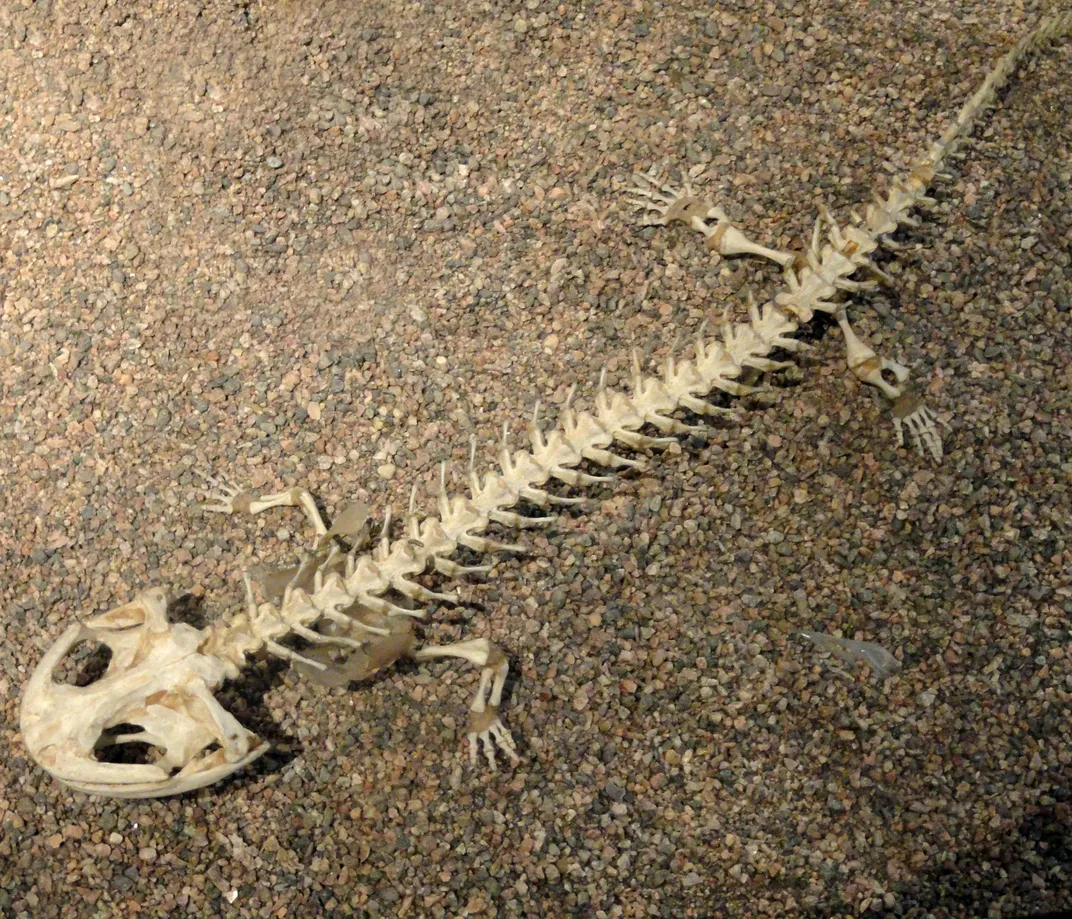Why This 18th-Century Naturalist Believed He’d Discovered an Eyewitness to the Biblical Flood
Smithsonian paleontologist Hans Sues recounts a colossal tale of mistaken identity
/https://tf-cmsv2-smithsonianmag-media.s3.amazonaws.com/filer/cb/9e/cb9ea40d-f899-472a-aa7e-2092181fcb9b/saam-198340_1.jpg)
Fossils have fascinated and puzzled humans since prehistoric times. They frequently have strange shapes unlike anything we know in the world around us today. And their mystery has confounded naturalists and scholars for centuries. Take for example, a strange skeleton that was uncovered near a small town in southern Germany in the early 18th century by a Swiss scholar who said he’d discovered the “bony frame of a man” that had drowned in the flood recounted in the Bible's book of Genesis.
Archaeological discoveries show that early members of our species already collected fossils and even used them for personal adornment. Throughout human history and across cultures, fossils were prized as amulets or used in folk medicine. For example, “tongue stones,” the teeth of the extinct shark Carcharocles megalodon from the island of Malta, were long thought to protect against poisons and snake bites.
But what are fossils? Philosophers in ancient Greece were the first to ponder this question. Yet neither the Greeks nor those of later ages answered it convincingly. Were fossils mere plays of nature, or ludes naturae? How did they form? Was it possible that they were the remains of ancient animals and plants?
Aristotle held that fossils grew within rocks due to an organic force or “seed.” Following him, most scholars posited the existence of such a force, or vis plastica, capable of creating structures that looked like animals and plants. Starting in the late Middle Ages, however, some forward-thinking savants started to see fossils as the remains of once-living creatures. The great Italian artist and polymath Leonardo Da Vinci was an early proponent of this idea.
This led to other theories based on observations of fossils in rock layers. Why were they sometimes found high in the mountains? Early scientists looked to the biblical story that told of a flood that was said to have covered the entire earth, and thus, to 17th-century scholars such as the Danish physician Nicholas Steno and the German mathematician and philosopher Gottfried Leibniz, it made perfect sense that fossils on mountain sides and deep in the ground had been left there in the wake of the flood. The English scholar John Woodward further developed this idea in his 1695 Essay Toward a Natural History of the Earth, where he proposed that once the waters began to recede, objects sank according to their weight, with the heaviest ones ending up at the bottom. This scenario, Woodward surmised, explained the layering of rocks observed in many places.

Woodward’s essay fascinated the Swiss physician and naturalist Johann Jakob Scheuchzer (1672-1733) so much so that he translated the essay into Latin, then the language of learning across Europe—giving it wide readership.
After studies in medicine and mathematics, Scheuchzer, a native of Zürich, had settled in his hometown to practice medicine. He eventually became the town’s physician and a professor at the local university. Incredibly curious about the world around him, Scheuchzer amassed a large collection of fossils, which led him to ponder their origin. And therein lies the tale of how Scheuchzer came to insist that the fossil he had acquired must have been a human witness to the flood.
For Scheuchzer, the biblical flood was the most plausible mechanism for the formation of fossils. He set out to gather scientific evidence—a proposition that aroused consternation among his fellow townspeople who regarded Scripture as the literal truth and in no need for verification. Indeed, the Zürich censors denied permission to print one of Scheuchzer’s books until he had purged all references to the Copernican theory of the solar system.
In his quest, Scheuchzer would get quite ahead of himself when he came across a fossil that, in his eyes, offered incontrovertible evidence that humans had perished in the biblical flood.

The fossil in question is an incompletely preserved strange skeleton that had been discovered in a limestone quarry near the small town of Öhningen in southern Germany. Scheuchzer identified his prize fossil as Homo diluvii testis, meaning “man, witness of the Flood.” In 1726 he published a broadside to announce his discovery. In his great work on the natural history of the Bible, Physica sacra of 1731, Scheuchzer cited the Reverend Johann Martin Miller as expressing the hope that the “sad bony frame of an old sinner” would soften the “heart of new children of evil!”
Scheuchzer’s interpretation of the Öhningen skeleton soon came under scrutiny. Other scholars considered the fossil the remains of a fish or a lizard. But Scheuchzer would go to his grave in 1733 convinced of his finding.

It was the great French zoologist and paleontologist Georges Cuvier, who finally demonstrated the true identity of the “witness of the flood.”
After Scheuchzer’s death, the Öhningen fossil had been acquired for the collections of Teylers Museum in Haarlem in the Netherlands, where it is still exhibited today. When that country was conquered by Napoleon’s army, Cuvier, then the emperor’s inspector of institutions for higher education, visited Haarlem in 1811.
With permission of the museum director, Cuvier examined Scheuchzer’s fossil and set out to expose the bones more clearly from the soft surrounding rock. Using a sharp needle, he uncovered the shoulder girdle and both arms of the animal. With that, Cuvier established the decidedly non-human skeleton was, in fact, that of an extinct giant salamander.
Today there are five living species of giant salamanders, four in East Asia and one, the Hellbender, Cryptobranchus alleganiensis, in the central and eastern United States. The Japanese giant salamander, Andrias japonicus, can attain a total length of about five feet.
The extinct species represented by the skeleton from Öhningen, now named Andrias scheuchzeri, is so similar to the Japanese one that some scientists regarded the two as a single species. The rocks from which Scheuchzer’s fossil was collected date from the Miocene Epoch and are about 13 million years old. They formed in a lake inside an extinct volcanic crater lined by forest.
Historians have puzzled over how a well-respected medical doctor could possibly have mistaken the skeleton of a giant salamander for that of a human. A plausible explanation is that, in his eagerness to find scientific proof of the biblical flood, Scheuchzer must have seen only what he wanted to see. Furthermore, giant salamanders were still unknown in Europe at that time.
While posterity remembers him mainly for his discovery of the alleged witness of the flood, Scheuchzer’s interpretation of fossils as the remains of once-living beings rather than products of some mysterious force was well ahead of his times. He was among the first to open humanity’s eyes to the fact that life has an inconceivably long history on our planet.
/https://tf-cmsv2-smithsonianmag-media.s3.amazonaws.com/accounts/headshot/HansDS2018.jpg)


/https://tf-cmsv2-smithsonianmag-media.s3.amazonaws.com/accounts/headshot/HansDS2018.jpg)